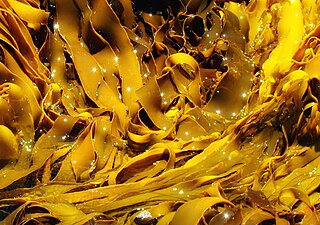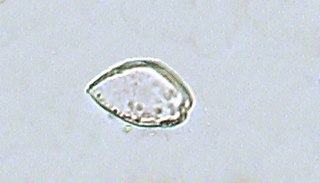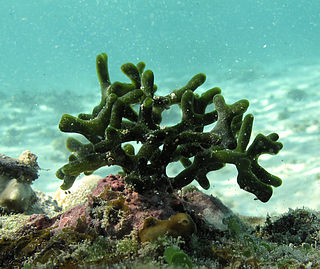Colaconema is a genus of marine red algae.
Colaconema is a genus of marine red algae.

Phycology is the scientific study of algae. Also known as algology, phycology is a branch of life science.

The Prorocentrales are a small order of dinoflagellates. They are distinguished by having their two flagella inserted apically, rather than ventrally as in other groups. One flagellum extends forward and the other circles its base, and there are no flagellar grooves. This arrangement is called desmokont, in contrast to the dinokont arrangement found in other groups. Accordingly, the Prorocentrales may be called desmoflagellates, and in some classifications were treated as a separate class Desmophyceae.

The Fucales (fucoids) are an order in the brown algae. The list of families in the Fucales, as well as additional taxonomic information on algae, is publicly accessible at Algaebase.

Codium is a genus of seaweed in the Chlorophyta of the order Bryopsidales. Paul Silva was an expert on the genus Codium taxonomy at the University of California at Berkeley. There are about 50 species worldwide.

Chordariaceae is a family of brown algae. Members of this family are may be filamentous, crustose with fused cells at the base, or they may be terete and differentiated into a central medulla and an outer photosynthetic cortex. They have a sporphytic thallus usually aggregated to form a pseudo-parenchyma.

AlgaeBase is a global species database of information on all groups of algae, as well as one group of flowering plants, the sea-grasses.
The history of phycology is the history of the scientific study of algae. Human interest in plants as food goes back into the origins of the species and knowledge of algae can be traced back more than two thousand years. However, only in the last three hundred years has that knowledge evolved into a rapidly developing science.
Bangia is an extant genus of division Rhodophyta that grows in marine or freshwater habitats. Bangia has small thalli with rapid growth and high reproductive output, and exhibits behavior characteristic of r-selected species. The plants are attached by down-growing rhizoids, usually in dense purple-black to rust-colored clumps. The chloroplasts of Bangia, like others in the division Rhodophyta, contain chlorophyll a and sometimes chlorophyll d, as well as accessory pigments such as phycobilin pigments and xanthophylls. Depending on the relative proportions of these pigments and the light conditions, the overall color of the plant can range from green to red to purple to grey; however, the red pigment, phycoerythrin, is usually dominant.

Chorda filum, commonly known as dead man's rope or sea lace among other names, is a species of brown algae in the genus Chorda. It is widespread in the temperate waters of the northern hemisphere. The species also has numerous other common names related to its physical appearance. Names include mermaid's tresses, cat's gut or sea-catgut, bootlace weed, sea-twine, and mermaid's fishing line.

Erythrotrichiaceae is a red algae family in the order Erythropeltidales.

Erythrotrichia is a red algae genus in the family Erythrotrichiaceae.

Rivularia is a genus of cyanobacteria of the family Rivulariaceae.
Cystoseira foeniculacea is a species of brown alga in the genus Cystoseira.

Phyllophoraceae is a family of red algae in the order Gigartinales.
Syracosphaerales is an order of algae consisting of three families:
Syracosphaeraceae is a family of algae consisting of the following genera:

Palmariales is an order of marine algae. It includes the edible seaweed dulse.
